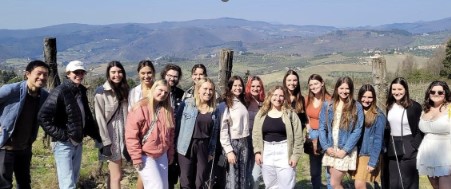How my CEA CAPA Classes Made me Fall in Love with the Culture of Italy
When determining what classes to take while studying abroad in Florence, I first decided to only take 13 credits rather than the usual 16. Personally, I didn’t need the credits to graduate, and I didn’t want to feel too overwhelmed, considering everything and everywhere in Europe I wanted to explore. The CEA CAPA study abroad classes I enrolled in were The Culture of Food and Wine, Introduction to Photography, Beginner Italian, and The Business of Food. Every course was very hands-on and gave us many different cultural experiences (high-impact practices) outside the traditional classroom.
One of my favorite activities in Florence was going for walks and looking for stunning street art. Clet Abraham is the artist of the street poster art below, and he had a beautiful studio in town where I got unique and artsy gifts for many people.

The Culture of Food and Wine
In this course, taught by the sweetest Italian woman ever, we split our study abroad semester into two categories. The first half of the semester focused on cheeses and the second half highlighted wine. We began the class by having tastings of Pecorino Cheese and Parmigiano Reggiano (it is not parmesan cheese in Italy), and even took a field trip to watch the mozzarella cheese making process. Then, in the second half of the semester, we started tasting three to four different wines each week. At the end of the semester, students had to pair one cheese with one wine and present it to the class on why it was a perfect pairing.

Our class sampled four different types of cheeses at the mozzarella factory as we learned about the cheese making process.
Introduction to Photography
Photography is something I always found very interesting. Naturally, when I saw photography course offerings abroad I said “why not” as I love taking pictures around the farms at home. In this class we constantly went out and explored new places to complete our four different projects. We visited neighboring towns to Florence, a modern art museum, an old asylum, different parks, bridges, and many other places inside and outside of the city center. Overall, this class showed us the importance of exploring what surrounded us and understanding this new place that we called home, but in a way that challenged us to look deeper than just at the surface level that we all were used to.

If you have ever traveled to Europe, you know the popularity and significance of a cigarette. In Italy almost everyone smokes, but opposite to America they all roll their own cigarettes which was always something I found interesting to watch no matter the person’s age.
Introduction to Italian
Before studying abroad in Italy, I taught myself a few very basic Italian phrases like “hello, good morning, how do you say…,” and a few other things using Duolingo in the months prior to leaving as I had no prior experience with Italian. The majority of the Italian I learned was from the Introduction to Italian class CEA CAPA offered to us and just gained the courage to try by going to the local markets and spoke specifically in Italian or went to dinner and only talked in Italian no matter the nerves it brought up. For me, a part of the study abroad program experience was speaking the language and to do that I set goals and let Italian class help me achieve them. In class we performed a lot of traditional classroom activities such as book work and presentations, but also spent a lot of time out and about trying to use our knowledge in the local markets and to find things.

This was the work of a local artist who we visited with our Italian professor. His work is sold at many designer stores all over the world.
The Business of Food
A much more traditional class I took was about the business side of the food market and how sustainable the Italian market is. In this class we heard from many different businesses such as Conad, the most popular grocery store in Italy, and heard their business plans, as well as many others. Yet, the thing that always interested me was that each business truly wanted to be “green” and have the smallest impact on the environment, so that was what they did. For example, Conad has four distribution centers that all meet at one hub and then to regional centers and lastly to the stores. Other things I learned about in this class were the worldwide business Eataly, a coffee grounds mushroom farm, shake café, and urban farmers.

This little clay figure was part of the watering system at the urban farm we went to, in this they can store water for long periods of time which in Florence could be months without rain.
Final Thoughts
My CEA CAPA classes truly helped me connect so much deeper than I ever could have imagined with Italian culture as well as to have a once in a lifetime experience. They also gave me the knowledge to bring some of the Italian culture home to my Italian American family by making pasta, ordering the perfect wine, teaching Italian phrases, or just showing pictures to connect to our heritage. I will forever be thankful for this life changing experience and hope you are looking forward to yours or are living your best life abroad now. CIAO!













